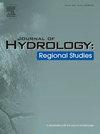Impact of Tropical Cyclone on Coastal Phytoplankton Blooms and Underlying Mechanisms
IF 4.7
2区 地球科学
Q1 WATER RESOURCES
引用次数: 0
Abstract
Study Region
Northern Beibu Gulf, China
Study Focus
This study examines the impact of tropical cyclone (TC) "Wipha" (2019) on phytoplankton chlorophyll-a (Chl-a) dynamics, using observations from two buoy stations (S1 and S2). Results indicate that persistently high turbidity at the inner bay (station S1) restricted underwater light availability, resulting in an insignificant change in mean daily Chl-a concentrations, despite sufficient nutrients. Conversely, at the outer bay (station S2), Chl-a significantly increased after the storm, exhibiting notable delayed correlations with elevated turbidity (r = 0.87, p < 0.01) and aerosol deposition (r = 0.90, p < 0.01). The differential phenomenon at two locations highlights that distinct environmental control the responses of phytoplankton dynamics to the tropical cyclone, primarily related to light availability and nutrient sources.
New Hydrological Insights for the Region
In contrast to prior studies, the nutrient source leading to increased Chl-a at the outer bay may result from wet deposition of aerosols and re-suspension of suspended matter, rather than direct terrestrial nutrient inputs. Additionally, the prolonged turbidity recovery period (up to 5 days) at the inner bay substantially limited phytoplankton growth, highlighting TC-induced turbidity as a critical factor constraining phytoplankton blooms in eutrophic coastal environments.
求助全文
约1分钟内获得全文
求助全文
来源期刊

Journal of Hydrology-Regional Studies
Earth and Planetary Sciences-Earth and Planetary Sciences (miscellaneous)
CiteScore
6.70
自引率
8.50%
发文量
284
审稿时长
60 days
期刊介绍:
Journal of Hydrology: Regional Studies publishes original research papers enhancing the science of hydrology and aiming at region-specific problems, past and future conditions, analysis, review and solutions. The journal particularly welcomes research papers that deliver new insights into region-specific hydrological processes and responses to changing conditions, as well as contributions that incorporate interdisciplinarity and translational science.
 求助内容:
求助内容: 应助结果提醒方式:
应助结果提醒方式:


